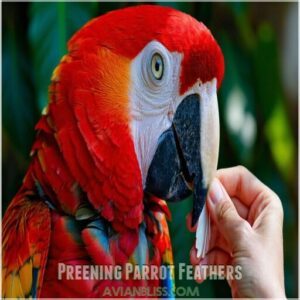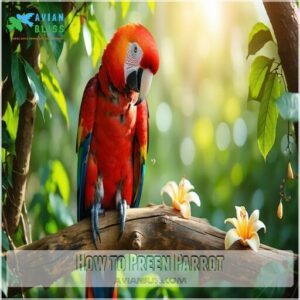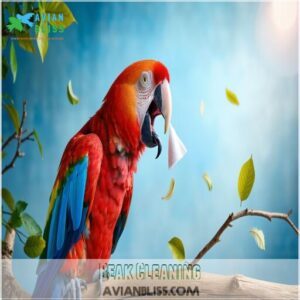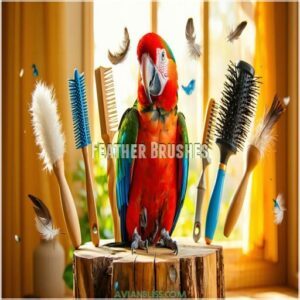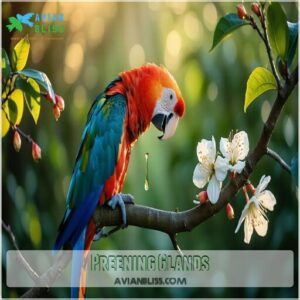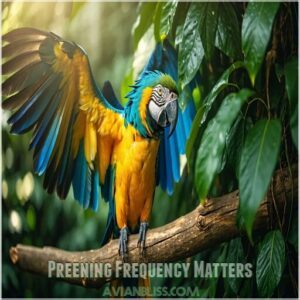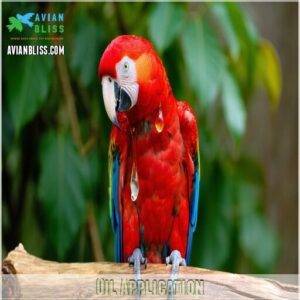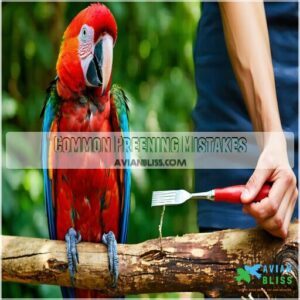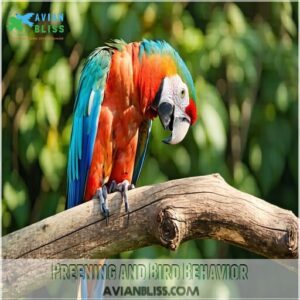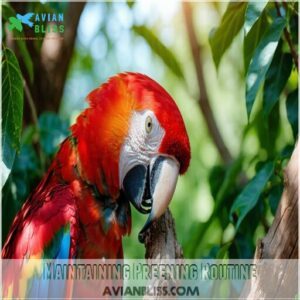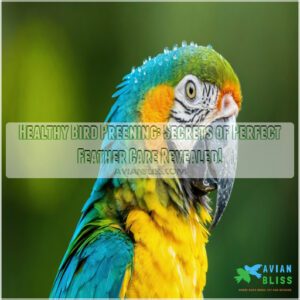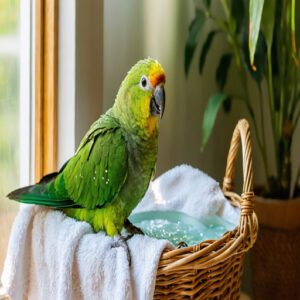This site is supported by our readers. We may earn a commission, at no cost to you, if you purchase through links.
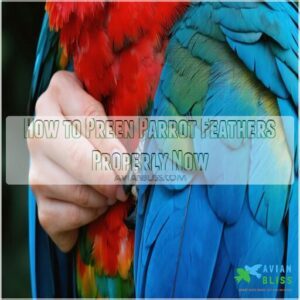
Start at the head and work your way down, carefully realigning each feather’s barbs and barbules with your parrot’s beak. Pay special attention to the wing feathers, where proper alignment is essential for flight.
During preening, your parrot’s uropygial gland releases oils that waterproof and protect their feathers – make sure these oils get distributed evenly.
The right preening technique doesn’t just keep your feathered friend looking sharp – it’s essential for their health, flight ability, and social bonding. Understanding the unique structure of each feather type transforms basic maintenance into an art.
Table Of Contents
- Key Takeaways
- Preening Parrot Feathers
- How to Preen Parrot
- Preening Tools Needed
- Preening Frequency Matters
- Parrot Preening Methods
- Preening for Health Benefits
- Common Preening Mistakes
- Preening and Bird Behavior
- Preening for Different Ages
- Maintaining Preening Routine
- Frequently Asked Questions (FAQs)
- What is preening & how do birds take care of their feathers?
- How do birds preen their feathers?
- How do birds care for their feathers?
- How long does a bird preen a feather?
- What preening techniques do birds use?
- Do birds need preening?
- How do you trim parrot feathers?
- How often should parrots preen?
- Should I let my parrot preen me?
- What does excessive preening look like?
- Conclusion
Key Takeaways
- You’ll want to start preening your parrot’s feathers daily, using gentle movements that mirror their natural behavior, and focus on wing feathers where proper alignment is crucial for flight ability.
- It’s essential to understand your parrot’s unique feather structure, including feather barbs and barbules, to master preening techniques that maintain feather texture and overall health.
- You should establish a regular preening routine, adjusting frequency and technique based on your parrot’s age, size, and individual needs, to keep their feathers clean, aligned, and in top condition.
- By preening your parrot’s feathers properly, you’ll not only keep them looking sharp, but also support their overall health and social bonding, so it’s crucial to get it right and make it a priority in your parrot’s care routine.
Preening Parrot Feathers
You’re about to learn how to preen your parrot’s feathers properly, which is essential for their health and well-being.
By following the right techniques, you’ll be able to keep your parrot’s feathers clean, aligned, and in great condition, ensuring they stay happy and healthy.
Importance of Preening
Preening is vital for parrot feather care, offering benefits like flight efficiency and social behavior.
Here are key reasons:
- Maintains bird hygiene
- Enhances feather condition
- Supports overall health
Mastering preening techniques is essential for parrot owners to ensure effective bird grooming and feather maintenance, making these techniques crucial for parrot owners to master for effective bird grooming and feather maintenance.
Feather Structure
You’ll examine the feather structure, including feather barbs, rachis alignment, and barbule smoothing, to understand how preening techniques maintain feather texture and quill maintenance, which is key to feather structure maintenance and overall feather anatomy, knowing feather barbules and proper feather care techniques.
Avian feather anatomy includes various types of feathers, each serving specific functions like insulation and flight.
Understanding bird feather functions is essential for proper parrot care.
Preening Techniques
You’ll master parrot grooming with techniques like feather cleaning, beak wiping, and wing stretching, plus oil application and barb smoothing, to keep your parrot’s feathers in top condition, ensuring a healthy, happy bird with these effective preening techniques and parrot grooming tips.
Proper bird preening techniques are essential for maintaining feather health and hygiene, which is crucial for a healthy, happy bird.
How to Preen Parrot
Now that you know why preening is important for your parrot’s health, it’s time to learn how to do it.
You’ll want to start by gently cleaning your parrot’s beak and feathers.
- Use a soft brush for feather care
- Focus on wing maintenance
- Prioritize parrot hygiene
- Master preening techniques for plumage management, ensuring proper feather growth and beak health with the right parrot grooming tips and bird preening tools.
Preening Tools Needed
You’ll need the right tools to preen your parrot’s feathers properly, including a beak cleaning tool, feather brushes, and an understanding of your parrot’s preening glands.
By using these tools correctly, you can help keep your parrot’s feathers clean, healthy, and well-maintained, which is essential for their overall well-being and appearance.
Beak Cleaning
You use a Beak Wipe for debris removal and bill cleaning, an important part of parrot beak care, to keep your parrot’s beak clean, promoting good bird hygiene practices and overall health.
Aiding in feather dust removal, a key preen aid, alongside nail care and beak trimming, is crucial for your parrot’s well-being.
Regular parrot beak care tools are essential for maintaining your parrot’s overall health.
Feather Brushes
You’ll need soft-bristled feather brushes for gentle strokes, an important part of parrot grooming tips and feather maintenance, utilizing the right cleaning tools for effective preening techniques in bird preening and feather cleaning methods.
Proper feather maintenance techniques are essential for parrot health and hygiene, ensuring proper feather care with various brush types.
Preening Glands
Now that you’ve got your feather brushes ready, let’s talk about the secret to your parrot’s shiny feathers: preening glands. Located at the base of the tail, these glands produce preen oil that keeps feathers clean, flexible, and waterproof.
You can find parrot preen gland oil products online. Here’s what you need to know:
- Preen glands produce a special oil that helps remove dirt and debris
- This oil is distributed through feathers using the beak
- Regular preening with preen oil is essential for maintaining healthy feathers
- Preen oil helps protect feathers from damage and keeps them shiny
- A healthy preen gland is key to your parrot’s overall feather care
Preening Frequency Matters
You’ll need to determine how often to preen your parrot’s feathers, as frequency matters for their health and well-being.
By establishing a regular preening routine, you can help keep your parrot’s feathers clean, aligned, and in good condition.
This is essential for their overall health and ability to fly.
Daily Preening Routine
Establish a daily preening routine to maintain your parrot’s feather care and health.
Set aside time for beak cleaning and use preening tools, focusing on feather maintenance and bird preening techniques to meet parrot grooming needs.
Promoting healthy feather health through regular daily preening routine and maintenance.
Preening After Bathing
After bathing, gently remove excess water.
Consider these steps:
- Feather drying
- Water removal
- Preening techniques to maintain feather care and oil gland maintenance, ensuring proper bird preening and feather cleaning for healthy feathers.
The goal is to maintain healthy feathers through proper care.
Preening During Molting
When your parrot is molting, gently remove pin feathers’ keratin sheaths, avoiding blood feathers.
Preening during this process requires care, as new feathers are sensitive.
Follow proper preening techniques to maintain healthy feather care, supporting your parrot’s overall well-being throughout the molting stages.
Regular feather care techniques are essential for maintaining your parrot’s health and appearance.
Parrot Preening Methods
You learn various parrot preening methods, including wing stretching, feather alignment, and oil application, to keep your parrot’s feathers clean and healthy.
By following these methods, you’ll be able to properly preen your parrot’s feathers, ensuring they remain in excellent condition for optimal health and well-being.
Wing Stretching
You’re focusing on wing stretching, a key preening method.
This wing exercise enhances aerodynamic efficiency, promoting parrot feather growth and maintenance.
Regular stretching techniques prepare your bird for flight, ensuring smooth preening techniques and overall bird grooming, which is key for healthy feather alignment and efficient flight preparation.
Feather Alignment
You’re aligning feathers for ideal flight.
- Feather Smoothing
- Barb Adjustment
- Wing Alignment aid in Plumage Maintenance and Flight Efficiency, using proper preening techniques for feather maintenance and parrot feather growth, ensuring good feather conditioning through feather alignment.
Using proper preening techniques is essential for plumage maintenance, ensuring the overall health and efficiency of the bird’s flight capabilities.
Oil Application
You apply oil to your parrot’s feathers using the uropygial gland’s sebum production, promoting waterproofing techniques and a healthy feather coating.
Understanding parrot oil benefits is essential for ideal feather care.
| Oil Types | Preen Glands | Feather Coating |
|---|---|---|
| Lavender | Uropygial | Smooth |
| Lemon | Preen | Shiny |
| Wild Orange | Oil Gland | Healthy |
Preening for Health Benefits
You’ll learn how preening helps parrots stay healthy by maintaining insulation, controlling parasites, and strengthening social bonds.
By preening your parrot’s feathers properly, you’ll be supporting their overall well-being and ensuring they lead a happy, healthy life, which is crucial for strengthening social bonds.
Insulation and Waterproofing
By preening, you enhance feather coating with water repellent preen oil, providing thermal insulation and weather proofing.
This is important for maintaining ideal feather condition through effective feather maintenance and preening techniques.
Including the use of feather conditioners for waterproofing and insulation is a key part of this process, which helps in maintaining the feathers.
Parasite Control
Regular preening is your frontline defense against feather mites, lice, ticks, and other ectoparasites.
Thorough feather cleaning removes debris and pests, like a tiny comb clearing out unwanted guests.
Think of it as pest management on a miniature scale!
- Mite Removal through preening
- Lice Control with regular cleaning
- Feather Cleaning disrupts pest lifecycles
- Debris Clearance prevents parasite hideouts
- Consider parasite treatments for severe infestations
Understanding bird preening behavior is essential for maintaining healthy feathers and preventing parasite infestations.
It is crucial to recognize the importance of preening behavior in birds and its impact on their overall health, particularly in preventing parasite infestations.
Social Bonding
You’ll find that mutual preening, or allopreening, strengthens social bonds, fostering trust and emotional bonding between birds, and even with you, through gentle bird interaction and social learning.
This interaction promotes a sense of mutual grooming and social preening, also known as mate grooming.
Common Preening Mistakes
You’ll want to avoid common preening mistakes that can harm your parrot’s feathers, such as overpreening or underpreening.
By understanding these mistakes, you can learn how to preen your parrot’s feathers properly and keep them healthy and strong.
Overpreening
You’re at risk of overpreening, causing feather damage.
- Over grooming
- Feather plucking
- Stress signals indicate preening anxiety, a common parrot feather problem, requiring gentle parrot grooming tips for proper feather maintenance.
This is a critical issue that affects many parrots, and recognizing stress signals is key to addressing the problem.
Underpreening
You must watch for underpreening, a form of feather neglect, which can lead to poor grooming, health risks, and feather damage.
This indicates preening deficits in your parrot’s maintenance, requiring attention to parrot feather maintenance and preening techniques with the right feather care products and parrot grooming tools.
Incorrect Preening Techniques
You can cause feather damage by overpreening or underpreening, leading to improper alignment and breakage.
Incorrect preening techniques, such as over grooming, can also harm your parrot’s feathers, emphasizing the need for proper feather maintenance and preening techniques to prevent errors and promote good feather care.
Preening and Bird Behavior
You’ll learn how preening affects your parrot’s behavior, including trust building and social hierarchy.
By understanding these concepts, you can develop a stronger bond with your parrot and help them maintain healthy, well-groomed feathers, which is crucial for their overall well-being and social hierarchy.
Trust Building
You build trust with your parrot through gentle touch, calm environment, and slow introduction to preening.
Patient handling is key to establishing a strong bird bonding experience, fostering mutual preening and social bonds, which strengthens trust in bird preening, an essential aspect of parrot behavior.
Understanding the concept of bird preening behavior can help owners recognize and respond to their parrot’s needs, promoting a healthier and more affectionate relationship with their parrot through mutual preening.
Communication
You’ll learn parrot communication through vocal cues, body language, and social signals, like feather talk and beak communication.
These aids are crucial in social bonding during mutual preening, or allopreening, a key aspect of bird preening that strengthens relationships.
Social Hierarchy
As you navigate parrot social structure, consider flock dynamics and dominance rules.
Key aspects include:
- Social learning
- Hierarchical structure
- Bird etiquette
- Mutual preening
- Allopreening, strengthening social bonds through social preening, within the parrot’s social hierarchy, which is crucial for social bonds.
Preening for Different Ages
You’ll need to adjust your preening technique based on your parrot’s age, as chicks, adults, and seniors have different needs.
As you learn how to preen your parrot’s feathers properly, consider the unique requirements of your bird’s life stage to confirm you’re providing the best care.
Chicks and Juveniles
When preening chicks and juveniles, you’ll focus on gentle feather care, using warm towels and soft rubbing to encourage healthy growth.
Aiding in young bird development and parrot feather maintenance, which is essential for fledgling preening and overall juvenile health, ensuring strong feather growth in baby birds, is crucial for their development.
Adult Parrots
As you care for your adult parrot, focus on feather care, beak health, and parrot nutrition.
Regular wing exercise and plumage maintenance are key for their well-being, ensuring healthy parrot feather maintenance through proper bird preening and parrot grooming tips.
Senior Parrots
Your senior parrot’s feathers need extra TLC as they age.
Gentle preening helps maintain aging feathers while avoiding blood feathers, which are more sensitive in elderly birds.
You’ll want to focus on careful beak care and gradual pin feather removal.
Keep preening sessions shorter but more frequent, and always watch for signs of discomfort.
Remember to mist your elder friend regularly – it’ll encourage natural preening behaviors and help with overall care, including gentle preening.
Maintaining Preening Routine
You’ll need to set up a consistent preening schedule that matches your parrot’s natural grooming patterns, typically 2-3 times daily after meals or baths.
You can maintain healthy feathers by checking their condition during each session and adjusting your technique based on your bird’s response to different preening methods.
You should also consider the importance of a consistent schedule, as it helps in establishing a routine that supports your parrot’s overall well-being, including their natural grooming patterns.
Scheduling Preening Sessions
After understanding your parrot’s age-specific needs, it’s time to create consistent preening schedules.
You’ll want to plan regular sessions when your bird is most alert and receptive.
- Schedule morning sessions after your parrot’s first meal
- Set aside 15-20 minutes for thorough feather checks during mid-afternoon
- Plan quick evening touch-ups before bedtime
Remember, timing these sessions with your bird’s natural preening cycles will make them more effective and enjoyable.
Monitoring Feather Health
Now that you’ve set your preening schedule, keeping tabs on your parrot’s feather health is your next priority.
Regular feather inspection helps catch issues early. Here’s a quick guide to common feather conditions:
| Condition | Signs | Causes | Action |
|---|---|---|---|
| Healthy Plumage | Smooth, bright feathers | Good care | Continue routine |
| Stress Bars | Dark lines across feathers | Poor nutrition | Improve diet |
| Broken Barbules | Ragged appearance | Physical damage | Gentle preening |
| Excessive Molting | Abnormal feather loss | Health issues | Vet check |
You’ll want to document any changes in your bird’s plumage during health checks to identify potential issues like Stress Bars or Excessive Molting, and take appropriate action to ensure your parrot’s feather health.
Adjusting Preening Techniques
Watch your parrot’s response as you modify preening techniques.
If they move away during wing grooming, try gentler strokes. Adjust your feather care approach based on their comfort level – some birds prefer quick preening sessions, while others enjoy longer tail maintenance routines.
When using parrot grooming tips, remember that beak management and preening styles should match your bird’s individual preferences and temperament.
Frequently Asked Questions (FAQs)
What is preening & how do birds take care of their feathers?
Imagine birds thoroughly cleaning feathers, you’ll learn preening is indispensable for their health, involving cleaning, aligning, and removing dirt to maintain insulation, flight, and waterproofing, an indispensable survival behavior.
How do birds preen their feathers?
You preen feathers by cleaning, aligning, and removing dirt, using your beak to nibble, rub, and smooth feathers for effective health and function, ensuring insulation and flight capabilities.
How do birds care for their feathers?
You care for feathers by cleaning, aligning, and removing dirt, using beaks, and applying preen oil for waterproofing and insulation, ensuring ideal condition for flight and overall health.
How long does a bird preen a feather?
You’ll spend around 2-5 minutes preening a feather, depending on its size and the bird’s species, to make sure it’s clean and well-maintained for maximum flight and insulation capabilities.
What preening techniques do birds use?
You’ll use techniques like puff and shake, beak cleaning, and oil application to loosen dirt, remove debris, and realign feathers for maximum function and waterproofing.
Do birds need preening?
A million times, you’ll wonder if birds need preening – absolutely, they do, as it’s important for their feather health, flight, and overall well-being, so yes, you must help them.
How do you trim parrot feathers?
You’ll trim parrot feathers carefully, cutting just the tip to avoid hurting your bird, and always follow a veterinarian’s advice to make sure your parrot’s safety and well-being.
How often should parrots preen?
Like a well-oiled machine, you’ll find parrots preen 2-4 times daily, depending on species and size, to keep their feathers in top shape and maintain their stunning appearance naturally.
Should I let my parrot preen me?
You can let your parrot preen you, but be cautious, as some birds may nip or bite, so observe their behavior and body language to guarantee a safe interaction always.
What does excessive preening look like?
You’ll notice excessive preening if your parrot obsessively cleans, plucks, or chews feathers, indicating anxiety, medical issues, or stress, so monitor their behavior closely.
Conclusion
Preening is the key to revealing your parrot’s health and happiness, like polishing a gemstone.
You’re now equipped to master how to preen parrot feathers properly, an essential skill for any parrot owner, by following the steps for learning how to preen parrot feathers properly.
- https://birdsupplies.com/blogs/news/your-ultimate-bird-preening-guide
- https://www.reddit.com/r/parrots/comments/w7jp3m/can_someone_please_tell_me_if_this_is_normal_he/
- https://www.parrotforums.com/threads/how-to-preen-new-feathers-without-hurting-your-bird.37213/
- https://en.wikipedia.org/wiki/Preening
- https://www.sciencedirect.com/topics/veterinary-science-and-veterinary-medicine/uropygial-gland

